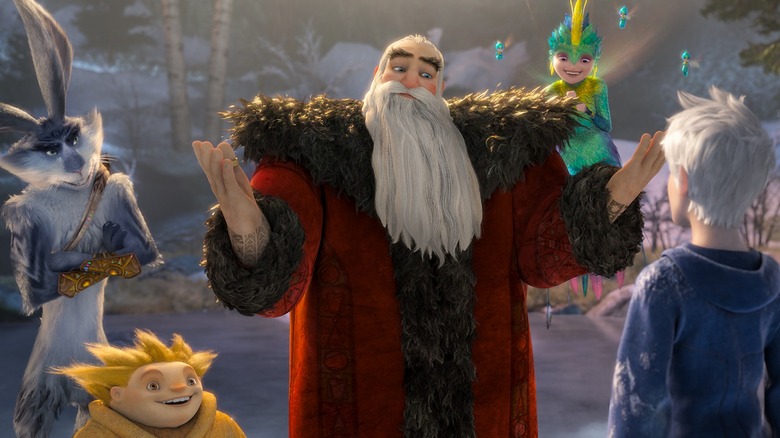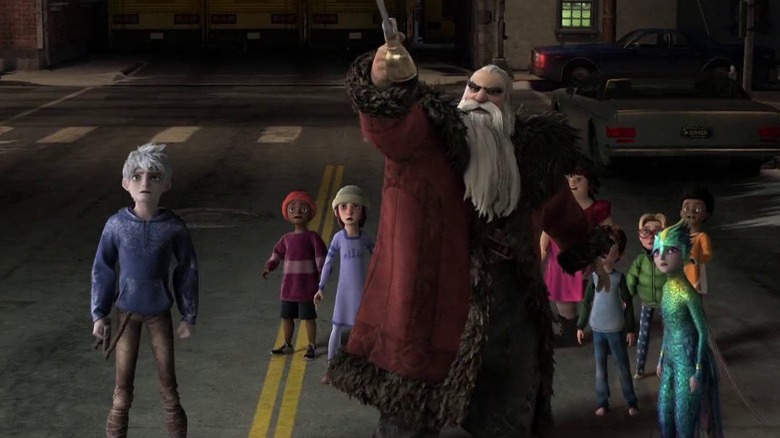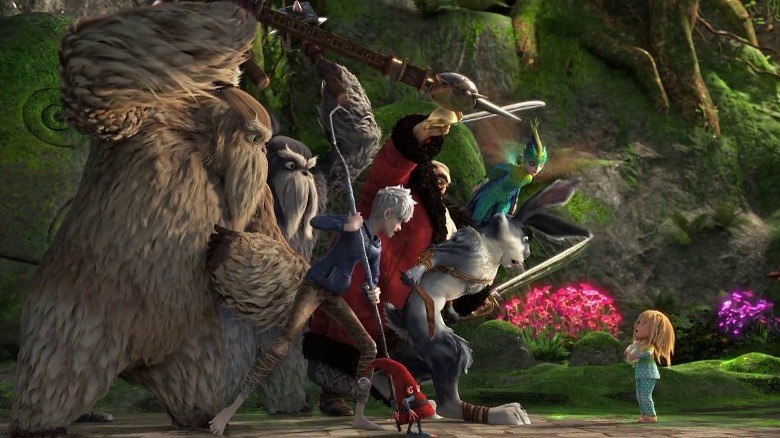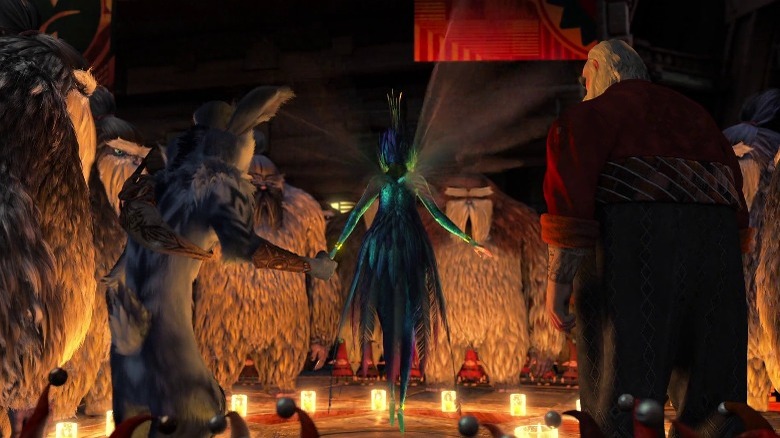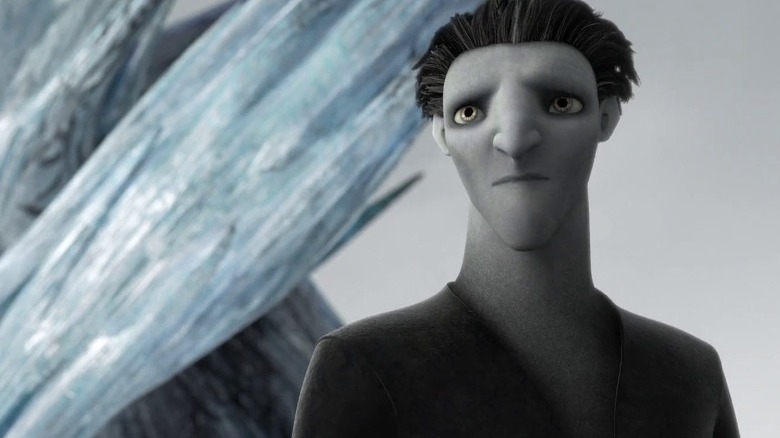Why Rise Of The Guardians Bombed At The Box Office
American animation is in an odd place. For creators, directors, and animators, the overriding cultural stigma against animation — that it's just for kids — probably provides a great deal of frustration. That's a joke even the Oscars make. It's a perception that limits the medium and reduces any potentially heady thematic material to something bland and easily digestible. Any material directed towards adults shifts into a mélange of innuendo and pop culture references, and children are condescended to in much the same way.
But even the movies that seem tailor-made for children's sensibilities get lost in the shuffle sometimes. 2012's "Rise of the Guardians," for instance, had a slam-dunk premise and an epic scale. It was a movie that took the fears of children seriously while also providing wildly entertaining set pieces, with beautiful animation and a star-studded cast. And yet, according to The Numbers, it didn't even make its production budget back domestically.
In theory, it is the ultimate "kid's movie" because of its characters and focus. What kid wouldn't want to see Santa Claus and the Tooth Fairy and the Easter Bunny teaming up to fight a primal vision of darkness? The "guardians" of the title are such holiday mascots, protecting the all-important innocence of children against forces of evil. It's almost too perfect a setup, applying an epic fantasy conflict to a familiar holiday backdrop. It even premiered near the end of the year, at a perfect time for movies about Santa Claus and an even more perfect time for family outings to the theater. What could have happened to keep the movie from being a success?
Iconic characters in an unfamiliar package
While most American children might recognize Santa Claus (Alec Baldwin), the version of him that exists in this movie is removed from the popular imagination. While not exactly on the level of David Harbour's Santa in 2022's "Violent Night," it's still a pretty hard turn. Besides his vague Russian accent (he uses the names of Russian composers as exclamations) and decidedly not-cozy demeanor, his role in the movie is less concerned with delivering gifts to kids and more with protecting the world from boogeyman Pitch Black (Jude Law). To that end, he leads a group called the Guardians.
But Santa is a supporting player, just like other Guardians E. Aster Bunny (Hugh Jackman), the Tooth Fairy (Isla Fisher), and the Sandman, who doesn't speak but represents the protection of children's dreams. Where Santa is the Guardian of Wonder, Bunny is the Guardian of Hope, and Tooth is the Guardian of Memories. As Santa receives news of the arrival of Pitch Black shortly before Easter, moves are made to summon a new Guardian. This turns out to be Jack Frost (Chris Pine), a 300-year-old ghostly adolescent prankster with ice powers who Bunny claims is only good for freezing pipes and "messing with egg hunts." This is decided on by The Man In The Moon, a godlike figure to whom the Guardians answer.
The lore in the movie doesn't really let up except for scenes where Jack pulls pranks on civilians who can't see him, including a child named Jamie (Dakota Goyo). Jack hates not being seen, and his invisibility represents a complex existential problem for him, one that he answers by acting out. The movie is not operating on the level of the familiar lowest common denominator kids' movie by any stretch.
The dark and the light
The fact that "Rise of the Guardians" uses characters from known folklore might also distract from its real source material: an original story and concept devised by artist and author William Joyce. As Joyce developed a book series (with a mix of picture books and chapter books) called "The Guardians of Childhood," the film was produced concurrently by DreamWorks. It presented a nice follow-up to the successful epic fantasy of their 2010 film "How To Train Your Dragon."
While "Guardians" is ultimately a beautiful, emotional fairytale, something of the narrative seems lost in translation. The mix of epic fantasy and childhood imagination plays a little awkwardly in practice.
The Guardians' power comes from children's faith in them, a bit like Santa's sleigh in "Elf," and if children ever fail to believe in them en masse, they will fade away. Pitch Black fights for that goal, causing fear and dashed dreams in the hearts of children. Despite being a nightmarish villain, his goal is geared toward one side of the movie, the more childish side, while the sense of lore and fantastical worlds seems to be operating in a more mature register. As director Peter Ramsey told Collider, the movie has a "'Star Wars' kind of structure where you are dropped into the middle of this larger conflict."
If the movie were able to walk one line or the other, the tonal divide might have been less problematic. Instead, it's a little too dark and existential to entirely be as cute as its cutest scenes, and too childish to appeal to the same big-hearted heroics of "How To Train Your Dragon."
The rough look
Even though the movie was directed by Peter Ramsey, who would eventually spearhead 2018's dazzling "Spider-Man: Into the Spider-Verse," "Rise of the Guardians" has a surprisingly bland and realistic visual style — one that's only accentuated by the movie's high-contrast animated cinematography. There are some beautiful, energetic action scenes, though, including Jack's fight with Pitch Black against a backdrop of icy mountains and a thrilling montage where the Guardians have to collect the Tooth Fairy's teeth across the globe.
Despite some really strong moments and, as in "How To Train Your Dragon," the involvement of legendary cinematographer Roger Deakins, the fairly serious sense of realism in the movie's visual style has a negative impact. As Ramsey told Collider, Deakins was able to use his insight to help ground the movie's visual style and the movie's "real" look.
While the designs of the movie's fantastical characters are mostly inspired, they lose some of what makes them special when rendered in 3D CGI environments with strong, evocative lighting. The facial designs of Jack Frost and the Tooth Fairy feel oddly inexpressive, and it's hard not to be put off by the smooth, textureless features of Pitch Black. Compared to the rich, but cartoony designs of some of the movie's contemporaries, like those featured in Pixar and Disney's films from 2012, "Guardians" has an unmemorable look.
The big hits of 2012
Those contemporaries presented an issue for "Rise of the Guardians" as well. Given that it looked on the surface to be a kids' movie rather than a "family movie" (where adults could reliably also love them), it likely failed to get all of the audience that saw Disney's animated film "Wreck-It-Ralph," which sent up '80s and '90s video games in a nostalgic, irreverent package. That movie, which came out just weeks before "Guardians," had irony on its side, a "Shrek"-esque folding of familiar pop-culture references into the story of an outsider finding himself. "Guardians" on the other hand is a fairly serious fantasy story whose subject matter would be most appealing to children who might be too young to follow it.
And besides "Wreck-It Ralph," older children were probably seeing movies like "Skyfall" or "The Twilight Saga: Breaking Dawn — Part 2." Fewer children were probably seeing Steven Spielberg's "Lincoln," but it still beat out "Rise of the Guardians" on its opening weekend. The movie's box office failure was significant for DreamWorks, leading to 350 firings and an $83 million loss for the company.
Despite the difficulties that faced the movie on arrival, it's still a special, imaginative, and deeply felt film. Even if families across America didn't exactly fall for it at the time, it's garnered a strong fanbase in the years since and remains a unique film for dealing with iconic childhood legends as characters in an epic fantasy.
